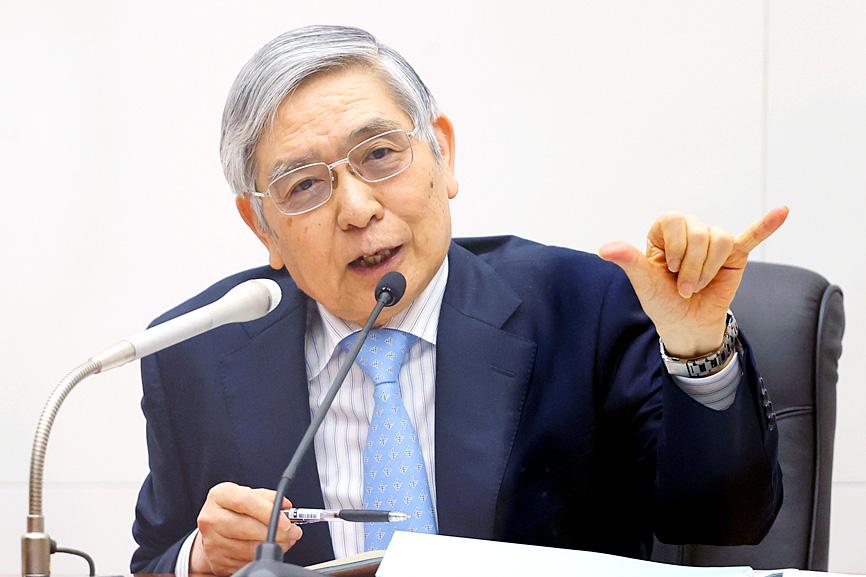The Bank of Japan (BOJ) yesterday hiked its full-year inflation forecast, but cautioned that it sees rising prices, driven by a surge in commodity costs caused by the Ukraine war, as a temporary and volatile trend.
Despite climbing prices and a slump in the yen to a 20-year low against the US dollar, the BOJ left its ultra-loose monetary policy unchanged.
It revised its inflation projection for the 2022-2023 fiscal year to 1.9 percent — sharply up from its previous forecast of 1.1 percent.

Photo: Suguro Yuma, Jiji Press/Bloomberg
The figure, which excludes fresh food, is just below the bank’s long-standing 2 percent target, but the BoJ views recent rises as a short-term trend and is calling for continued efforts to achieve sustainable economic growth.
Consumer prices are “likely to increase temporarily to around 2 percent — due to the impact of a significant rise in energy prices — in fiscal 2022,” it said.
“However, the rate of increase is expected to decelerate, because the positive contribution of the rise in energy prices to the CPI [consumer price index] is likely to wane,” it said.
Last month, core consumer prices rose 0.8 percent — the fastest increase in more than two years — as oil prices soared.
However, excluding energy, prices were down 0.7 percent.
Although the bank’s revised inflation forecast is “broadly in line” with its 2 percent target, “a hike to the policy rate remains off the table as none of the acceleration in inflation is being driven by domestic demand,” Tom Learmouth of Capital Economics wrote.
The BOJ now expects the economy to grow 2.9 percent this fiscal year, against its previous forecast of 3.8 percent. However, it also predicted a 1.9 percent expansion in 2023-2024, from its previous projection of 1.1 percent.
Bank policymakers left their inflation forecast for 2023-2024 unchanged at 1.1 percent.
The announcement followed a two-day policy meeting and comes with the yen at its weakest level against the US dollar since 2002, because of the widening gap between Japan’s loose monetary policy and the US Federal Reserve’s increasingly hawkish tilt.
The BOJ has suggested that the benefits of a weaker yen, particularly for major Japanese exporters, outweigh the disadvantages, but this messaging has become more difficult to sustain in the face of growing concern.
A weaker yen is particularly problematic for resource-poor Japan, which relies on energy imports, and in recent weeks, politicians have expressed concern about the speed of the currency’s slump.
However, no intervention appears on the horizon, although the government this week unveiled a new economic package including cash handouts for low-income families and an expansion of fuel subsidies to cushion the impact of rising prices.

The US dollar was trading at NT$29.7 at 10am today on the Taipei Foreign Exchange, as the New Taiwan dollar gained NT$1.364 from the previous close last week. The NT dollar continued to rise today, after surging 3.07 percent on Friday. After opening at NT$30.91, the NT dollar gained more than NT$1 in just 15 minutes, briefly passing the NT$30 mark. Before the US Department of the Treasury's semi-annual currency report came out, expectations that the NT dollar would keep rising were already building. The NT dollar on Friday closed at NT$31.064, up by NT$0.953 — a 3.07 percent single-day gain. Today,

‘SHORT TERM’: The local currency would likely remain strong in the near term, driven by anticipated US trade pressure, capital inflows and expectations of a US Fed rate cut The US dollar is expected to fall below NT$30 in the near term, as traders anticipate increased pressure from Washington for Taiwan to allow the New Taiwan dollar to appreciate, Cathay United Bank (國泰世華銀行) chief economist Lin Chi-chao (林啟超) said. Following a sharp drop in the greenback against the NT dollar on Friday, Lin told the Central News Agency that the local currency is likely to remain strong in the short term, driven in part by market psychology surrounding anticipated US policy pressure. On Friday, the US dollar fell NT$0.953, or 3.07 percent, closing at NT$31.064 — its lowest level since Jan.

Hong Kong authorities ramped up sales of the local dollar as the greenback’s slide threatened the foreign-exchange peg. The Hong Kong Monetary Authority (HKMA) sold a record HK$60.5 billion (US$7.8 billion) of the city’s currency, according to an alert sent on its Bloomberg page yesterday in Asia, after it tested the upper end of its trading band. That added to the HK$56.1 billion of sales versus the greenback since Friday. The rapid intervention signals efforts from the city’s authorities to limit the local currency’s moves within its HK$7.75 to HK$7.85 per US dollar trading band. Heavy sales of the local dollar by

The Financial Supervisory Commission (FSC) yesterday met with some of the nation’s largest insurance companies as a skyrocketing New Taiwan dollar piles pressure on their hundreds of billions of dollars in US bond investments. The commission has asked some life insurance firms, among the biggest Asian holders of US debt, to discuss how the rapidly strengthening NT dollar has impacted their operations, people familiar with the matter said. The meeting took place as the NT dollar jumped as much as 5 percent yesterday, its biggest intraday gain in more than three decades. The local currency surged as exporters rushed to